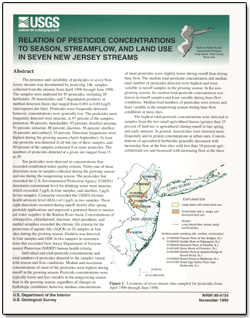Water-Resources Investigations Report 99–4154

AbstractThe presence and variability of pesticides in seven New Jersey streams was documented by analyzing 146 samples collected from the streams from April 1996 through June 1998. The samples were analyzed for 85 pesticides, including 50 herbicides, 28 insecticides, and 7 degradation products, at method detection limits that ranged from 0.001 to 0.018 µg/L (micrograms per liter). Pesticides were frequently detected; however, concentrations were generally low. The pesticides most frequently detected were atrazine, in 97 percent of the samples; prometon, 96 percent; metolachlor, 95 percent; desethyl-atrazine, 91 percent; simazine, 88 percent; diazinon, 58 percent; alachlor, 56 percent; and carbaryl, 54 percent. Detection frequencies were highest during the growing season (April-September). At least one pesticide was detected in all but one of these samples, and 49 percent of the samples contained 9 or more pesticides. The numbers of pesticides detected at a given site ranged from 13 to 29. Ten pesticides were detected at concentrations that exceeded established water-quality criteria. Thirty-one of these detections were in samples collected during the growing season and one during the nongrowing season. The pesticides that exceeded the U.S. Environmental Protection Agency (USEPA) maximum contaminant level for drinking water were atrazine, which exceeded 3 µg/L in four samples, and alachlor, 2 µg/L in two samples. Cyanazine exceeded the USEPA liftime health advisory level (HAL) of 1 µg/L in two samples. These eight detections occurred during runoff shortly after spring pesticide applications and represent a potential threat to municipal water supplies in the Raritan River basin. Concentrations of chlorpyrifos, chlorthalonil, diazinon, ethyl-parathion, and methyl-azinphos exceeded the chronic life criteria for the protection of aquatic life (ACQR) in 20 samples at four sites during the growing season. Dieldrin was detected in four samples and DDE in two samples at concentrations that exceeded New Jersey Department of Environmental Protection (NJDEP) human health criteria. Individual and total-pesticide concentrations and total numbers of pesticides detected in the samples varied with season and flow conditions. Median and maximum concentrations of most of the pesticides were highest during runoff in the growing season. Pesticide concentrations were typically lower and less variable in the nongrowing season than in the growing season, regardless of changes in hydrologic conditions; however, median concentrations of most pesticides were slightly lower during runoff than during base flow. The median total-pesticide concentration and median total number of pesticides detected were highest and most variable in runoff samples in the growing season. In the nongrowing season, the median total-pesticide concentration was lowest in runoff samples and least variable during base-flow conditions. Median total numbers of pesticides were lowest and least varibale in the nongrowing season during base-flow conditions at most sites. The highest total-pesticide concentrations were detected in samples from the two small agricultural basins (greater than 25 percent of land use is agricultural) during runoff in late spring and early summer. In general, insecticides were detected more frequently and in greater concentrations at urban sites. Concentrations of agricultural herbicides generally decreased with increasing flow at the four sites with less than 10 percent agriculture land use and increased with increasing flow at the three sites with more than 25 percent agricultural land use. Most of the pesticides that correlated positively with streamflow were detected at sites where land use in the basin would indicate the use of those particular pesticides. Most of the pesticides that correlated negatively with streamflow were present at the site in the Coastal Plain or at sites in which the land use in the basin would not indicate heavy use of those particular pesticides. |
For additional information contact: Part or all of this report is presented in Portable Document Format (PDF); the latest version of Adobe Reader or similar software is required to view it. Download the latest version of Adobe Reader, free of charge. |
Reiser, R.G., 1999, Relation of pesticide concentrations to season, streamflow, and land use in seven New Jersey streams: U.S. Geological Survey
Water-Resources Investigations Report 99–4154, 20 p.
Abstract
Introduction
Study Approach
Presence and Distribution of Pesticides
Water-Quality Criteria
Detection Frequency
Concentrations
Total-Pesticide Concentration and Numbers of Pesticides Detected
Relation of Concentration to Streamflow
Summary and Conclusions
References Cited